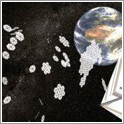Satellite Swarms Dynamics and Control
A satellite swarm is an ensemble of mutually interacting spacecraft performing a number of tasks in a coordinated manner.
Research Milestones

Swarm intelligence methods can be used to design the controllers of a large number of satellites, but can also be useful in connection with near-term problems involving a small number of them (i.e. formation flying). See AI pages for more information.
A hybrid propulsion system exploiting electrostatic interactions between spacecrafts (Coulomb forces) to aid the electric propulsion system significantly reduces the DV amounts needed for formation keeping.
Aiding a self-assembly procedure using Coulomb forces is dynamically feasible.
Project overview
Space engineers are currently developing autonomous systems and envisaging space missions that would certainly benefit from a deeper understanding of the collective behaviour of similar, but also dissimilar spacecraft. Multi-robot planetary exploration, on-orbit self-assembly and satellites swarm for coordinated observations are just examples of what could be achieved if our technology level was proved to be sufficient to provide spacecraft swarm with autonomous decision capabilities. The ACT research in this area, and in particular the contribution given by the mission analysis and design expertise, focuses on the feasibility of designing controllers for these complex systems. As an example we seek to answer questios such as: is it possible to build large solar panels or large antennas exploiting collective emerging behaviours of satellites swarms?

The use of swarm intelligence methods is also very relevant for advanced missions architectures such as APIES and ANTS that take advantages of multiple spacecraft to explore the asteroid belt. Because of these synergies between collective robotics and space mission design, it is interesting to design a decentralized control for a satellite swarm relying upon the lesson learned from collective robotics. Using a behaviour based approach it is possible for a satellite swarm to acquire and mantain a number of formations using only limited sensing capabilities and without making use of intersatellites communications.
The ACT is also trying to completely rethink these type of missions introducing novel propulsion concepts able to diminish the DV requirment on each swarm component. The use of inter-satellites Coulomb forces is being investigated.